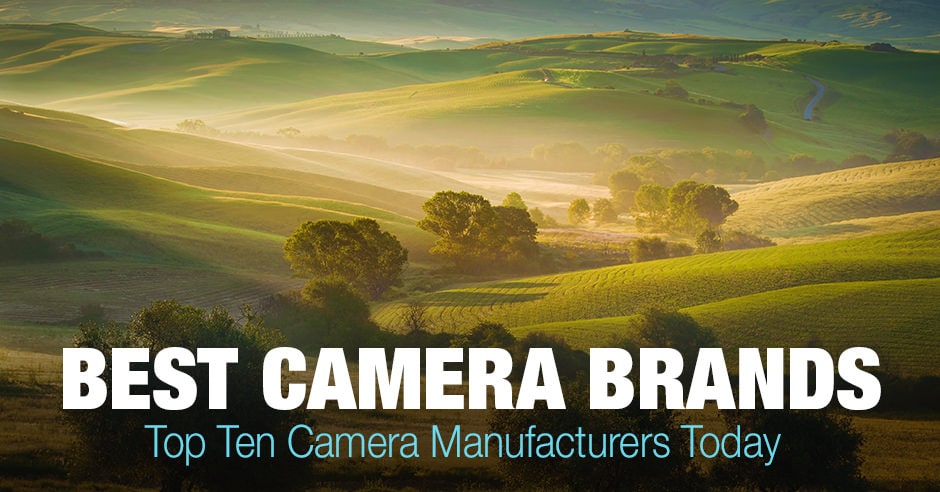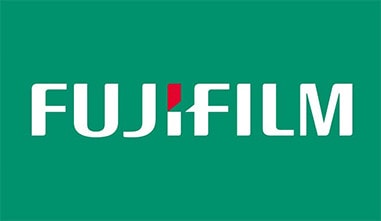Are you struggling to determine the best camera brands that exist today? Do you find yourself overwhelmed by the number of camera brands on the market, and you’re just not sure where to turn?
You’ve come to the right place.
Because this article is going to give you an overview of all the best camera manufacturers out there. You’ll discover who they are and what they offer.
First, I’ll talk about the biggest and most relevant players in today’s camera market: Canon, Nikon, and Sony. For many years, Canon and Nikon have dominated the digital photography space–but in recent years, Sony has become the main competitor (particularly in the mirrorless market).
Next, I’ll discuss smaller brands, such as Fujifilm (which creates APS-C cameras and recently entered the medium-format market), Panasonic (which uses its own Micro Four Thirds system to create quality cameras), and Olympus (which designed the original Four Thirds system and working on an impressive mirrorless lineup).
By the time you’ve finished this article, you’ll know all about the top camera brands – and you’ll come away knowing the best camera brand for your photography.
Let’s dive right in.
Five best camera brands dominate the global digital camera market. Canon, Sony, Nikon, Fujifilm, and Panasonic are the major players in this space. According to recent reports Sony and Canon dominate the market. Canon tops the list with 46.5% market share, followed by Sony with 26.1%, and Nikon claiming 11.7%. Fujifilm and Panasonic follow with 5.8% and 4.2%, respectively. It shows a clear dominance of Canon over other digital camera brands.
94.1% is the share of the top 5 companies.
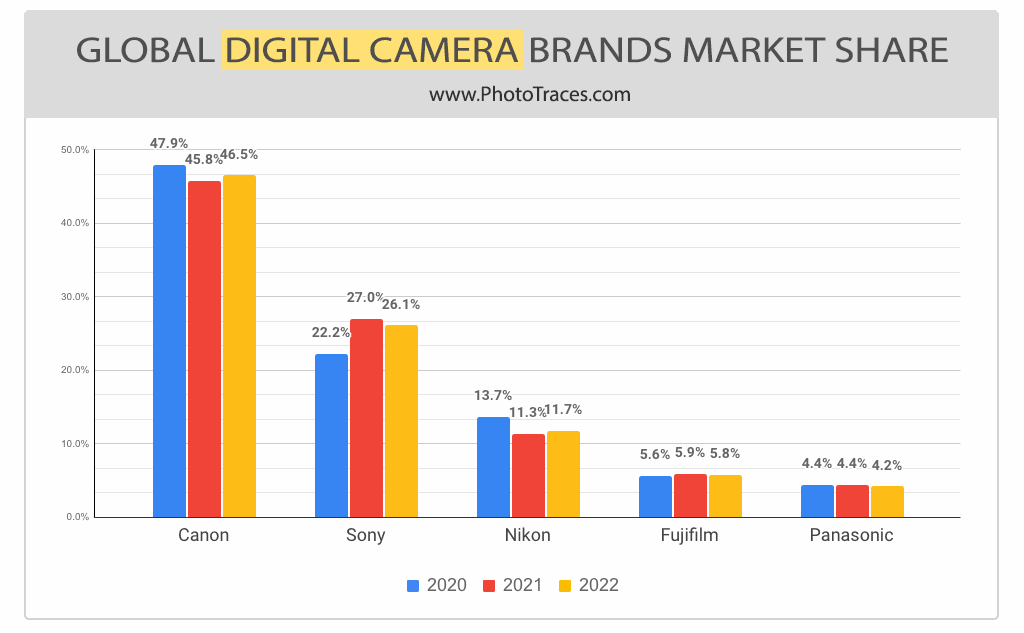

However, you should take into consideration that Canon and Nikon still sell plenty of Digital SLR cameras. At the same time, Sony, Fujifilm, and Panasonic only manufacture mirrorless camera models.
If we check the dynamic from 2020 to 2021, we can see an increase in the market share of Canon, Sony, and Fujifilm at the expense of Nikon, Panasonic, and other smaller players such as Olympus.
The global mirrorless camera market is an ever-evolving industry, with popular brands competing for the top market share.
Sony and Fujifilm have about 10 years of a headstart on Nikon and Canon. But in recent years, brands like Nikon and Canon have heavily invested in mirrorless technologies. As a result, Canon is about to catch up with the biggest player in the mirrorless market, Sony.
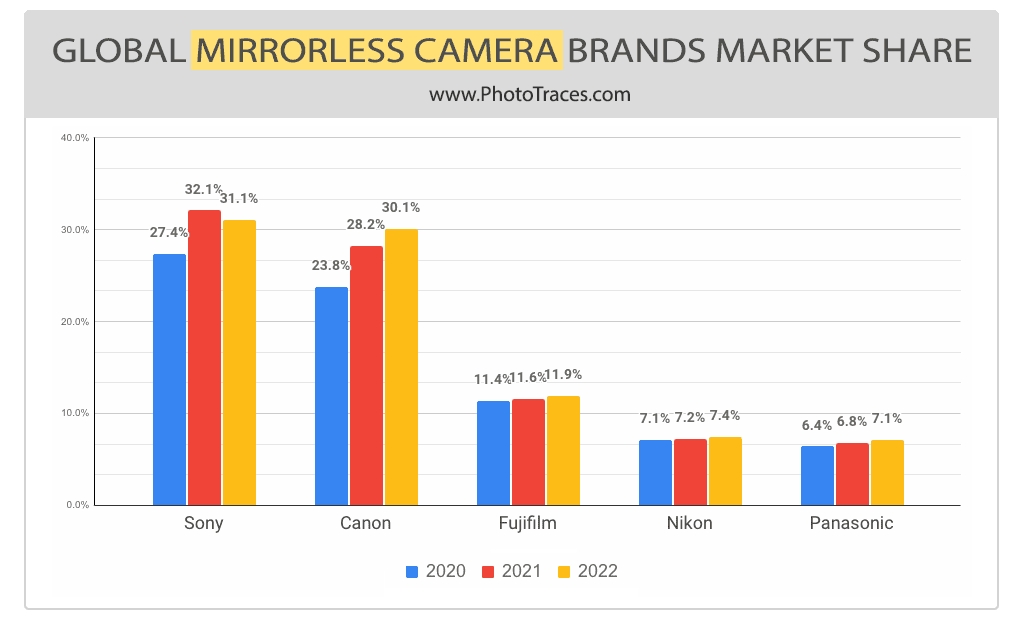

Currently, there are five major players in this field: Sony, Canon, Fujifilm, Nikon, and Panasonic. According to recent statistics, Sony holds the largest portion of the market share at 31,1%, followed by Canon with 30,1%, Fujifilm at 11,9%, and Nikon at 7,4%.
10 Best Camera Brands Today
As I explained above, this article reviews the best camera brands and explains their place in today’s digital camera world.
The first brands on this list are the most relevant to photography today.
And while the remaining brands are still
important, they don’t come close to competing with the big players in the camera
space.
Now let’s take a look at the biggest camera
company out there:
1. Canon
As a current leader in the camera industry, Canon is renowned for its high-quality DSLRs and diverse lens lineup.
Founded in 1937, Canon has been responsible for several groundbreaking advancements throughout the 20th century: It was the first to integrate a micro-computer in a camera, introduce a camera with eye-controlled AF, and make image-stabilized lenses widely available.
Despite shrinking market conditions, Canon has maintained an impressively broad product portfolio in the industry. The company continues to manufacture its own sensors (both full-frame and APS-C), cameras, lenses, and accessories.


Canon EOS R6
Canon’s best selling full frame mirrorless camera
Currently, Canon offers multiple DSLR lines for both hobbyists and professionals, comprising the renowned 1D X series, the 5D series (Mark IV, Mark V) , and the Rebel series. Canon also provides top-notch point-and-shoot compact cameras, including the Canon Powershot series.
Insights into Canon’s Mirrorless Cameras Lineup
While Canon has long been a powerhouse in the fields of DSLRs, video cameras, and lenses, its foray into the mirrorless market is relatively nascent but promising. Canon’s mirrorless models – embodied in their EOS M and EOS R series – represent a notable push from the brand to adapt to the evolving demands of today’s photographers.
The EOS M series, the first mirrorless line launched by Canon in 2012, is designed to cater to beginners and enthusiasts. These cameras offer a balance of performance and price and feature an APS-C sensor.
The EOS R series, introduced in 2018, caters more to professional and advanced amateur photographers. Inheriting the proud pedigree of Canon’s classic EOS line, the EOS R series features full-frame sensors and high-speed, wide-area autofocus.
One notable feature across all Canon digital mirrorless cameras is the implementation of Dual Pixel AF, contributing to fast and accurate autofocusing. Canon’s Color Science is another key value proposition, offering photographers accurate and visually appealing colors straight out of the camera.
What to Expect from Canon’s Mirrorless Future
As photographers increasingly opt for mirrorless models over traditional DSLRs, Canon is expected to explore further developments in this trend. The brand has already indicated plans to cease new developments for its EF lenses and shift focus to its RF mount lenses made for the mirrorless EOS R series. This strategic move is not only indicative of their commitment to the mirrorless revolution but also offers the potential for a wide range of innovative lens designs.
Canon’s upcoming EOS R releases are rumored to feature next-level technology. We’ve heard the whisper of advancements in sensor technology, expanded dynamic range, and even higher resolution capabilities, which if true would significantly reinforce Canon’s position as a formidable competitor in the mirrorless market.


Canon EOS R10
Canon’s best selling mirrorless APS-C camera
While Canon has traditionally worked at a cautious pace, there’s reason to believe that the company may expedite its mirrorless developments to cater to the market’s rapid shift. In the face of competition from major players like Sony and Fujifilm, Canon is undeniably compelled to push the boundaries of its mirrorless offerings.
For many photographers considering a mirrorless transition, it often boils down to the choice between Sony’s technology prowess and Canon’s color, build quality and lens selection. Nonetheless, it’s an exciting time as Canon progresses within the mirrorless market, always promising a better, more innovative future.
Best Selling Canon Camera Models
| Model | Level | Camera Type | Sensor Type | Sensor Size | W. Sealed | IBIS | Price |
|---|---|---|---|---|---|---|---|
| Canon Rebel SL3 | Entry Level | DSLR | APS-C | 24MP | No | No | Price $ |
| Canon Rebel T7 | Entry Level | DSLR | APS-C | 24MP | No | No | Price $ |
| Canon Rebel T8i | Entry Level | DSLR | APS-C | 24MP | No | No | Price $ |
| Canon 90D | Mid Range | DSLR | APS-C | 33MP | Yes | No | Price $$ |
| Canon M50 | Entry Level | Mirrorless | APS-C | 24MP | No | No | Price $ |
| Canon EOS R10 | Entry Level | Mirrorless | APS-C | 24MP | No | No | Price $ |
| Canon EOS R7 | Mid Range | Mirrorless | APS-C | 33MP | Yes | Yes | Price $$ |
| Canon EOS R6 | Advanced | Mirrorless | Full Frame | 24MP | Yes | Yes | Price $$$ |
2. Nikon
Nikon, a prominent player in the imaging industry, stands as a significant rival to Canon, particularly in the consumer and professional camera segment. Its genesis traces back to 1917, when three heavyweight optics manufacturers founded it, marking the start of its ascent to a leading position in the optics business.
Currently, Nikon boasts an array of top-tier DSLRs in its product lineup, including classics such as the Nikon D850 and the Nikon D5, which is expected to be succeeded soon by the D6. The lineup also includes some robust mirrorless contenders like the Z6 and Z7 for full-frame photography enthusiasts, and the Z50 for those preferring the APS-C format. Nikon’s Coolpix range serves the point-and-shoot camera market segment.
In terms of image quality and dynamic range deliverance, Nikon comes up as a preferred choice among professionals, often earning glowing accolades.


Nikon Z7
Nikon’s flagship full frame mirrorless camera
Facing Challenges in the Mirrorless Market
Nikon’s move into the mirrorless market hasn’t been seamless. Entering late into a scene largely controlled by Sony, Nikon faced its fair share of learning pains linked to adapting to this advanced and high-in-demand technology.
Despite mixed reviews, Nikon introduced the Z6 and Z7 mirrorless cameras with noteworthy features, offering fantastic image quality and a sturdy build. However, critics hit out at features, most notably the single card slot and limited native lens options. These shortcomings raised questions about Nikon’s mastery of the mirrorless market.
Moreover, when it comes to mirrorless autofocus technology, Nikon lags behind Sony or Canon which have maximized phase detection. Nikon needs to step up its game to better compete in this area.
Nikon’s Recovery
Despite financial challenges, Nikon shows promising recovery signs. The company has recently implemented cost-saving strategies, mainly in its imaging product business, a significant revenue contributor.
Nikon has started focusing less on low-cost DSLRs and more on high-earning mirrorless cameras like Z6 and Z7. This change towards the high-end market should help raise their profits.
Nikon’s strong financial management helps the company during these hard times. A healthy list of assets, lots of cash in reserve, and manageable debts give Nikon a steady base in an unstable market.


Nikon Z50
Nikon’s best selling mirrorless APS-C camera
Finally, Nikon focuses on research and innovation to stay updated in the fast-changing camera industry. As more people prefer mirrorless cameras, Nikon’s ongoing investment in research could help speed up its financial recovery.
While full financial recovery may take time, Nikon’s recent measures signify a commitment to resilience, ensuring it remains a competitive player in the imaging industry.
Best Selling Nikon Camera Models
| Model | Level | Type | Sensor Type | Sensor Size | W. Sealed | IBIS | Price |
|---|---|---|---|---|---|---|---|
| Nikon D3500 | Entry Level | DSLR | APS-C | 24MP | No | No | Price $ |
| Nikon D5600 | Mid Range | DSLR | APS-C | 24MP | No | No | Price $ |
| Nikon Z50 | Entry Level | Mirrorless | APS-C | 21MP | No | No | Price $ |
| Nikon D7500 | Advanced | DSLR | APS-C | 21MP | Yes | No | Price $$ |
| Nikon D780 | Advanced | DSLR | Full Frame | 25MP | Yes | No | Price $$ |
| Nikon Z5 | Mid Range | Mirrorless | APS-C | 24MP | Yes | Yes | Price $$ |
| Nikon Z7 | Advanced | Mirrorless | Full Frame | 46MP | Yes | Yes | Price $$$ |
3. Sony
Sony, established in 1946, entered the digital camera market in 1988. The company’s foothold in the camera industry significantly strengthened in 2006 when it acquired Konica Minolta’s camera division, placing Sony as one of the top direct competitors with leading camera manufacturers and instrumental in the dominance of the mirrorless camera sector.
Currently, Sony is the top producer of digital sensors globally, so dominant that it supplies sensors to counterparts including Nikon, Fujifilm, and Panasonic.


Sony a7 III
Sony’s top selling full frame mirrorless camera
Thanks to its preeminence in sensor technology, Sony has a competitive advantage in crafting its own APS-C and full-frame cameras, known for stunning image quality and advanced focusing accuracy. Its wide market presence facilitates swift innovation, leading to high-end range of cameras such as the Sony Alpha a7R IV, the a6600, and the top end a9 Mark II within Sony’s mirrorless camera range.
Related: Sony a6100 vs a6400
Two standout features solidify Sony’s leading role in sensor technology: the dynamic range of its cameras and its unmatched autofocus technology.
The Dynamic Range of Sony Cameras
A significant feature that sets Sony cameras apart is the high dynamic range of their sensors. For instance, top-of-the-line models like the Sony a7R IV and the Sony a9 II can resolve an impressive 15 stops of dynamic range.
This means that in a single frame, Sony cameras can record a wide range of luminance, preserving exceptional detail in both highlights and shadows. This feature positions Sony cameras as superior choices for photography in high-contrast environments (landscape photography) or situations with complex lighting, where it is crucial to maintain detail throughout varying levels of brightness.
Sony’s Autofocus Excellence
Sony has set a benchmark for autofocus systems with pioneering technology. Its real-time eye autofocus and tracking stand as a testament to this innovation, offering photographers precision in capturing high-quality images.
Sony’s Eye AF technology is AI-driven, enabling the camera to pinpoint and focus on a subject’s eyes with unwavering accuracy, even when the subject is in motion or amidst challenging light scenarios. This technology is indispensable for portrait photographers aiming to produce sharply focused images with depth and distinction.
Moreover, Sony’s animal eye AF feature caters to wildlife photographers, ensuring animals in motion are photographed with crisp, focused eyes.


Sony a6600
Sony’s top rated mirrorless APS-C camera
Despite these advancements, Sony sometimes receives criticism for ergonomics. Sony’s camera bodies are compact and filled with advanced technology, but they may lag in comfort and the intuitive feel provided by Canon’s larger DSLR models. This could be a noteworthy concern for those who prioritize ergonomics and intuitive handling.
Best Selling Sony Camera Models
| Model | Level | Type | Sensor Type | Sensor Size | W. Sealed | IBIS | Price |
|---|---|---|---|---|---|---|---|
| Sony A6100 | Entry Level | Mirrorless | APS-C | 24MP | No | No | Price $ |
| Sony A6400 | Mid Range | Mirrorless | APS-C | 24MP | Yes | No | Price $ |
| Sony A6600 | Advanced | Mirrorless | APS-C | 24MP | Yes | Yes | Price $$ |
| Sony A7 III | Advanced | Mirrorless | Full Frame | 24MP | Yes | Yes | Price $$ |
| Sony A7 IV | Advanced | Mirrorless | Full Frame | 24MP | Yes | Yes | Price $$$ |
| Sony A7R V | Pro Level | Mirrorless | Full Frame | 61MP | Yes | Yes | Price $$$$ |
4. Fujifilm
Fujifilm is one of the top camera brands on the market. It is primary known for its APS-C mirrorless cameras, and, most recently, its medium-format and instant cameras. At the time of writing, Fujifilm ranks as the fourth-largest player in the digital camera industry.
Fujifilm has a long history in the camera market, going back to 1934 – and it spent several years competing with the dominant force in the camera industry at the time, Eastman Kodak.
X-Trans Sensors
Fujifilm, while using Sony’s image sensors, distinguishes itself with the innovative X-Trans filter array. This proprietary technology sets Fujifilm apart by providing an alternative to the traditional Bayer filter pattern used in most cameras. The X-Trans filter is designed to minimize moiré and false colors without the need for an optical low-pass filter, resulting in sharper, more detailed images.


Fujifilm XT5
arguably the best APS-C camera today
Leader in APS-C Segment
Regarded as a powerhouse in the APS-C (crop sensor cameras) camera market, Fujifilm’s offerings are often considered best-in-class. Standout products like the Fujifilm X-T5 and the Fujifilm X-H2 are testaments to the brand’s commitment to excellence in this category. These cameras offer photographers high resolution and wide dynamic range, packed into robust, compact bodies within Fujifilm’s mirrorless camera lineup.
Fujifilm Unique Design
Fujifilm’s cameras are instantly recognizable due to their distinctive design characteristics. Reminiscent of classic film cameras, they feature mechanical dials and tactile controls that are both ergonomic and aesthetically pleasing. This homage to traditional photography resonates with enthusiasts who appreciate a more hands-on approach to shooting settings.
Related: Switching from Sony to Fujifilm
The unique retro design philosophy of Fujifilm cameras has fostered a dedicated and almost cult-like following among photographers. These aficionados value not only the cameras’ performance but also the experience of using a tool that feels both nostalgic and state-of-the-art.
GFX Medium Format
In addition to its celebrated APS-C lineup, Fujifilm has made significant strides in the medium format market with its GFX series. Offering the most affordable medium format cameras available today, Fujifilm has made this once-prohibitive format more accessible to a broader audience.
Fujifilm Color Science


Fujifilm XS10
best entry-level APS-C camera today
Another distinctive feature of Fujifilm cameras is color science. Fujifilm’s color science is rooted in a legacy of film manufacturing, translating decades of expertise into its digital cameras to produce exceptional color rendition that is both vibrant and true to life. This heritage informs the creation of their Film Simulation modes, which meticulously emulate the look of classic Fujifilm analog film stocks.
Best Selling Fujifilm Camera Models
| Model | Level | Type | Sensor Type | Sensor Size | W. Sealed | IBIS | Price |
|---|---|---|---|---|---|---|---|
| Fujifilm XT-30 | Entry Level | Mirrorless | APS-C | 26MP | No | No | Price $ |
| Fujifilm X-T5 | Advanced | Mirrorless | APS-C | 40MP | Yes | Yes | Price $$ |
| Fujifilm X-H2 | Pro Level | Mirrorless | APS-C | 40MP | Yes | Yes | Price $$ |
| Fujifilm X-E4 | Entry Level | Mirrorless | APS-C | 26MP | No | No | Price $ |
| Fujifilm X-S10 | Mid Range | Mirrorless | APS-C | 26MP | No | Yes | Price $ |
| Fujifilm X-T4 | Advanced | Mirrorless | APS-C | 26MP | Yes | Yes | Price $$ |
5. Panasonic
Founded in 1918, Panasonic initially focused on electronics before branching out into the realm of digital photography with its Lumix brand. The company has earned recognition for its high-performance cameras.
Micro Four Thirds
Despite its recent forays into the full-frame mirrorless market, the company remains a staunch advocate for Micro Four Thirds technology. In partnership with Olympus, Panasonic played a pivotal role in creating the Micro Four Thirds System, allowing for cross-brand lens compatibility – Olympus lenses can be mounted on Panasonic bodies with ease.
Panasonic’s Micro Four Thirds cameras offer exceptional image quality, dynamic range, low-light performance, and a small form factor. This robust performance, combined with the distinctive advantages of the Micro Four Thirds system, ensures that Panasonic remains a key player in this market segment, catering to both professional and enthusiast photographers alike.
The extensive range of Micro Four Thirds lenses available from both Panasonic and Olympus, as well as third-party manufacturers, gives photographers an expansive selection of creative options, from ultra-wide-angle to telephoto, including fast primes and versatile zooms. This compatibility and shared ecosystem reinforce the practical and creative benefits of staying committed to the Micro Four Thirds format for a significant portion of Panasonic’s business strategy.
Panasonic’s Videography
Panasonic’s expertise in imaging extends well beyond traditional photography, with its Lumix line achieving a sterling reputation for video performance. The brand’s foray into the realm of videography is marked by features such as 4K video recording, robust image stabilization, and advanced color science, which have made Lumix cameras a favored choice among professional videographers and content creators.
The Panasonic Lumix GH6, for instance, has established itself as a trailblazer in the industry, offering unmatched video features in a mirrorless camera. With its ability to shoot 10-bit 4:2:2 internally and cinema 4K resolution, this camera has set high standards for color depth and video clarity, satisfying the needs of even the most discerning videographers and filmmakers.


Panasonic LUMIX GH6
top choice for video recording
Full Frame
Further expanding its product line, Panasonic introduced the high-end Lumix S5, which builds on the company’s video prowess while offering the advantages of a full-frame sensor. The S5 combines the best of both worlds for photo and video enthusiasts: the depth of field and low-light performance characteristic of full-frame photography, with the robust video capabilities that Lumix cameras are known for.
Panasonic’s collaboration with Leica has led to the development of superior Lumix Leica lenses, tailored for full-frame cameras.
Best Selling Panasonic Camera Models
| Model | Level | Type | Sensor Type | Sensor Size | W. Sealed | IBIS | Price |
|---|---|---|---|---|---|---|---|
| Panasonic G95 | Mid Range | Mirrorless | Four Thirds | 20MP | Yes | Yes | Price $ |
| Panasonic G100 | Entry Level | Mirrorless | Four Thirds | 20MP | No | No | Price $ |
| Panasonic GH6 | Advanced | Mirrorless | Four Thirds | 25MP | Yes | Yes | Price $$$ |
| Panasonic S5 | Pro Level | Mirrorless | Full Frame | 24MP | Yes | Yes | Price $$$ |
6. Olympus
The journey of the Olympus camera business began in 1936, and it has adeptly navigated through the transitions from film to digital and the emergence of mirrorless technology, continuing to deliver high-quality mirrorless cameras and DSLRs to today’s consumers.
In partnership with Kodak, Olympus developed its own camera system tailored for DSLRs: the Four Thirds System. This innovation later evolved into the Micro Four Thirds system through collaborative efforts with Panasonic. The Micro Four Thirds system, featuring a smaller sensor format, is now utilized by numerous manufacturers, with Olympus and Panasonic as notable proponents.


Olympus E-M1 Mark III
Olympus’ flagship mirrorless model
The Four Thirds System, with its crop-sensor advantage, enables the creation of high-quality digital images. Olympus has built upon this technology by incorporating advanced in-body image stabilization and superior weather-sealing capabilities into its camera bodies, offering photographers reliable tools for various shooting conditions.
Despite fierce competition in the digital camera market, Olympus has held a position of respect. Nonetheless, in a notable shift, the Olympus camera division was sold to Japan Industrial Partners in January 2021. The acquisition gave rise to OM Digital Solutions, which now manages the production and sales of Olympus-branded cameras.
As a result of this purchase by the holding company, the future of Olympus cameras has become uncertain. Loyal users and industry experts are keenly watching the developments under the new ownership, wondering whether OM Digital Solutions will continue the legacy of innovation that Olympus is known for or take a new direction altogether.
Best Selling Olympus Camera Models
| Model | Level | Type | Sensor Type | Sensor Size | W. Sealed | IBIS | Price |
|---|---|---|---|---|---|---|---|
| Olympus E-M10 III | Entry Level | Mirrorless | Four Thirds | 20MP | No | Yes | Price $ |
| Olympus E-M1 III | Advanced | Mirrorless | Four Thirds | 20MP | Yes | Yes | Price $$ |
7. Pentax
In an era where every camera brand is investing heavily in mirrorless technology, Pentax stands out for its dedication to DSLRs. While competitors like Canon and Nikon work to match Sony’s mirrorless offerings, Pentax continues to produce its renowned full-frame and medium-format DSLRs, including the Pentax K-1 and the Pentax 645 series.
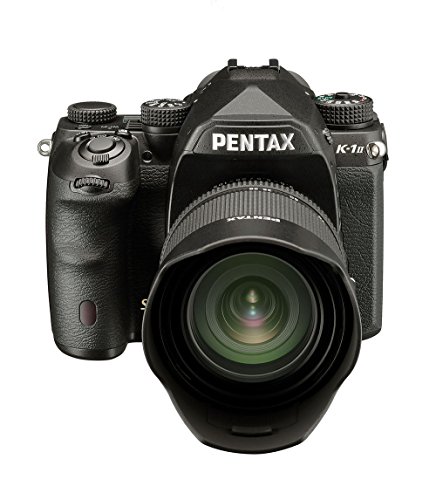

Pentax K-1 Mark II
Pentax top rated full frame DSLR camera
Established in November 1919, Pentax has navigated through a series of significant changes in the past decades. The company underwent a merger with Hoya in 2006, followed by a notable shift in 2011 when Ricoh acquired the Pentax imaging business. Under Ricoh’s ownership, Pentax’s commitment to DSLR technology persists.
Pentax has built a reputation for crafting exceptionally durable DSLRs. However, it’s uncertain whether this focus on traditional DSLR technology will hold up against the rising popularity of mirrorless cameras.
Best Selling Pentax Camera Models
| Model | Level | Type | Sensor Type | Sensor Size | W. Sealed | IBIS | Price |
|---|---|---|---|---|---|---|---|
| Pentax K-1 Mark II | Advanced | DSLR | Full Frame | 36MP | Yes | Yes | Price $$$ |
| Pentax K-3 III | Advanced | DSLR | APS-C | 26MP | Yes | Yes | Price $$ |
8. Leica
Leica, established in 1869, has long been a big player in the world of photography, known for its significant contributions to film photography. However, the shift to digital technology presented challenges for Leica, necessitating a transformation in strategy to maintain its market position.
In response to the digital revolution, Leica has concentrated on expanding its L-mount mirrorless camera system, which features both APS-C and full-frame models. In a strategic partnership forged in 2018, Leica teamed up with Sigma and Panasonic to develop a range of L-mount lenses, compatible with cameras from both Panasonic and Leica cameras, enhancing the versatility of their system.
Leica’s offerings are celebrated for their impeccable aesthetics and impressive ergonomics, embodying a fusion of tradition and modern craftsmanship. Despite this, the high cost and perceived slower pace of technological advancement have led to critiques that Leica’s cameras may not align with the value expectations of some photographers.
As a result, Leica has faced the challenge of retaining its allure in a tech-driven industry while staying true to its legacy of quality and design excellence.


Leica Q – $5K APS-C camera
9. Hasselblad
Hasselblad is an imagining company with a rich history, going back to 1841, and is synonymous with high-end imaging equipment. Its medium-format cameras are renowned not only for their exceptional quality but also for their iconic role in documenting human history, having been the cameras of choice for the Apollo program astronauts.
As of 2020, Hasselblad’s product lineup includes several medium-format cameras, amongst which the X1D-50c stands out. This camera has been recognized as a groundbreaking innovation, earning the title of the first camera with mirrorless medium-format digital technology. Such cameras, often priced above $6000, firmly establish Hasselblad’s gear as dedicated tools for professional photographers who demand the utmost in image resolution and quality. You get what you pay for.
Reflecting the brand’s status in the industry, Hasselblad was of such strategic interest that it caught the attention of DJI, the leading drone manufacturer. In a move that underscores the blending of imaging prowess with cutting-edge technology, DJI acquired a majority stake in Hasselblad.
This acquisition promises to usher in an era of enhanced collaboration, potentially integrating Hasselblad’s legendary imaging capabilities with DJI’s innovative aerial platforms, and opening new horizons in photography and videography.
10. Kodak
Mention film photography, and people immediately think ‘Kodak,’ – for a good reason. Eastman Kodak is the company that invented color film photography and dominated the film photography business for much of the 20th century.
Though Kodak was the company to invent digital photography, it failed to account for the digital explosion. This led to financial insolvency in the 2000s, at which point the company declared bankruptcy and sold off a slew of its patents. While Kodak still exists as a company, it no longer produces camera equipment.
So while you can find used Kodak equipment at camera shops and on eBay, any new camera gear bearing the Kodak label is produced by none-Kodak manufacturers who license the Kodak name.
FAQ: Best Camera Brands
Why Do People Love Fujifilm So Much?
As a Fujifilm shooter, I can tell why I love Fujifilm cameras.
First, it is because of their aesthetics, unique form factor, and controls. Fujifilm cameras are like a natural bridge between film and digital photography. Inside, it has all the advanced tech as any other brand but uses unique mechanical controls that mimic old film cameras. Some people like it, but some prefer a more modern design.
Before shooting with Fujifilm, I used Canon and Sony cameras, and I prefer the mechanical dials approach for controlling the camera.
Second, Fujifilm has a customer-friendly approach to updating old cameras through firmware updates. You can have a 3-year-old model and then upgrade its software for free, extending its functionality to the latest features that did not exist when you bought the camera. It eliminates the need to upgrade your cameras often to have access to the newest tech.
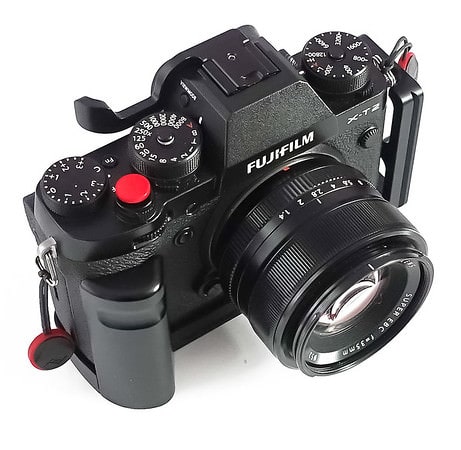

Is Fujifilm Better Than Canon
If you evaluate the two brands, Canon is still the photography industry leader. It has an unprecedented number of camera and lens models. No matter what type of photography you do, Canon has a combination of the camera body and quality lens for you.
But if you look at one segment of digital cameras, crop sensor (APS-C) cameras, Fujifilm has an edge.
Fujifilm’s advantage is that it does not manufacture Full Frame cameras, and all its efforts and RND budget are invested in the APS-C cameras and lenses. On the other hand, Canon emphasizes the Full Frame market and, as a result, neglects the crop sensor segment. Since I have no plans to switch from an APS-C to a Full Frame model, Fujifilm builds better cameras for my needs.
But at the same time, if I had to use Canon cameras, it would not limit my photography. It is just more fun to use Fujifilm.
Does Fujifilm Use Sony Sensors?
In the modern times of global consolidation, all camera manufacturers, except Canon, use Sony sensors. Sony is today’s biggest and most advanced manufacturer of digital sensors.
Even though Fujifilm uses Sony sensors, it managed to put a unique spin on it. It developed an X-trans filter array. The filter array is responsible for interpreting the colors captured by digital sensors. It means that if you have 2 identical Sony sensors used by different companies, Fujifilm will produce a different look and image quality.
Once again, some photographers love X-trans sensors, but some prefer a traditional Bayer filter array (Nikon, Sony, Pansonic, Olympus).
Even though X-trans sensors bring some challenges, their advantages justify their existence. I learned how to deal with challenges and want Fujifilm to continue using the X-trans sensors.
What is the Best Canon Camera for Beginners?
There are plenty of choices for beginners in the Canon line of digital cameras.
Canon still manufactures DSLR camera models, which are a fantastic choice for beginners. For example, Canon Rebel T8i is a great choice.
If you want to take a mirrorless approach, the apparent choice is Canon EOS R10.
Do any Professional Photographers Use Nikon?
Absolutely. In recent years Nikon had bad press because of its marketing missteps. Even now, Nikon is struggling financially. But it never prevented Nikon from designing and manufacturing great cameras.
Today, Nikon sells the best DSLR cameras ever made in both full-frame and APS-C segments (D850 and D500).
Plus, Nikon has the most loyal users. They had to wait a little longer for Nikon to produce top-notch mirrorless modes, but today, Nikon has a complete mirrorless line of cameras, from entry-level to pro-level models (Z50, Z5, Z7).
Is Canon Easier to Use than Nikon?
No, it is not. Two leading brands have different menu systems, different ways of customization, and body designs. I can not say that one brand is easier to use than another; it is just different. You need to learn and get used to it.
Is Nikon Discontinuing DSLR Cameras?
I don’t have inside information regarding the Nikon DSLR line, but at the time of writing, Nikon still manufactures and sells DSLR modes. And D3500 and D5600 models are still great choices for beginners.
Is Fujifilm Better than Sony
Both brands manufacture excellent APS-C cameras. I switched to Fujifilm after shooting for 4 years with Sony models (a6xxx). I prefer Fujifilm. But I have to admit it is a personal preference.
See also: Fujifilm vs Sony
But since Fujifilm does not produce full-frame cameras, Sony has an edge in this segment.
If, at some point, I decide to move from the APS-C form factor to Full Frame, the obvious choice will be Sony.
But I believe that Fujifilm produces better APS-C cameras.
Is Canon Rebel Good for Beginners?
The Canon Rebel is the most popular line in digital photography of all time. Most professional photographers working today started their journey with Rebels (including myself).
And even today, Canon Rebels is an excellent choice for anybody starting with photography. But at the same time, I suggest starting with the mirrorless model Canon R10. Mirrorless is the future, and DSLR is the past.
Best Camera Brands | Final Thoughts
Now that you’ve finished this article, you should be familiar with the ten best camera brands out there today–and you should have a sense of the perfect camera brand for your needs.
Remember that Nikon, Canon, and Sony are the ‘big three’ among the digital camera companies, while Fujifilm, Olympus, and Panasonic are more specialized brands. Pentax, Leica, and Hasselblad, are struggling to remain relevant unless you’re in the market for a medium-format camera (Hasselblad), and Kodak is now completely obsolete.
So pick a camera brand and get shooting!


